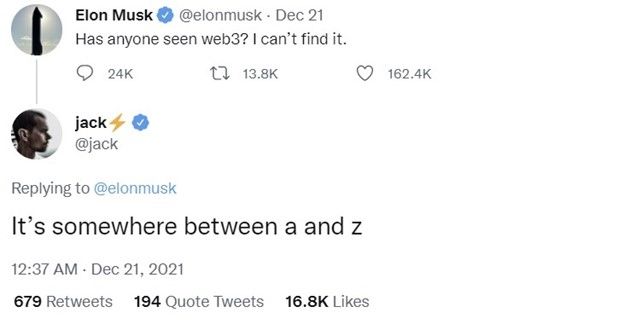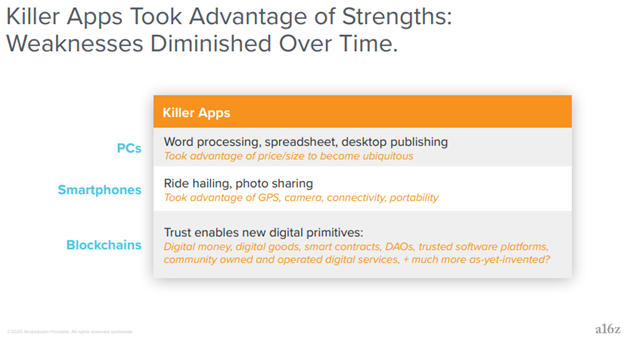a16z Crypto Summer School Study Notes- 1
Recently, it was discovered that A16Z had a Crypto Startup School in the spring of 2020, and the course content and briefings were open. After watching a few episodes, I thought the content was good, so I decided to try to record some learning notes.
Andreessen Horowitz ("a16z") is a very well-known venture capitalist in Silicon Valley and a strong promoter of Web 3. Even though Jack Dorsey and Elon Musk on Twitter a while ago were hyping up Web 3 and being dominated by venture capital. But anyway, I think this series of a16z films in 2020 is still worth learning.

[Building a blockchain world]
Closer to home. The first video speaker was Chris Dixon, a16z GP. The theme of this class is Crypto Networks and Why They Matter , which clearly introduces what blockchain is and the problems it wants to solve. The briefing is here.
Although cryptocurrencies are chaotic and dangerous in the eyes of the outside world/media, they are skyrocketing. But Chris Dixon believes that when the price attracts everyone's attention, interest and inspiration are aroused, and various projects/new innovations appear to build the entire ecosystem.
Just like the previous article mentioned that Ray Dalio uses eight indicators to measure the cycle of the world order, and Chris Dixon also uses four quantitative data to measure, I think using data to support arguments is one of the necessary conditions for a good article. Here, he uses the BTC price and cryptocurrency-related developer activities/new ventures/social media activities as indicators to separate out three waves of innovation in 2010-2012/2012-2016/2016-2019. Highs and lows, but they all created/left behind many important constructions in the cryptocurrency world.

[Blockchain Architecture]
Just like computers, mobile phones, and even electric cars or VR headsets, blockchain is actually a computing platform. In ordinary life, we either own computers (PCs, cell phones) or rent them from others (like AWS for cloud computing, or FB/Google - actually running on these companies' computers). But, as the recent Ukrainian-Russian war has shown, tech giants can and can sanction, and people with computers can change their minds.
The architecture of a blockchain computer is a computer composed of thousands of nodes, which are based on a physical computer network and are connected together through a consensus mechanism.

The node mechanism allows anyone to join the blockchain network and become part of the blockchain computer without consent. At the same time, node design usually uses game theory to encourage honest operation of nodes. And how many nodes will be jokingly called the computer room chain? How many nodes are enough for decentralization? This has been one of the concerns of various L1 competitions over the past year or two.
Consensus mechanisms can aggregate votes from nodes to ensure that the blockchain works correctly. The result of each round of voting becomes a block, and then these blocks are chained together in sequence, thus, as the name suggests, a blockchain. There are many kinds of consensus mechanisms, which will be sorted out in the next few videos about Prof. Dan Boneh.
With the game design and consensus mechanism behind the nodes, the blockchain can provide trust guarantees to all stakeholders, such as users, developers, enterprises, etc., which greatly solves other problems in human history. Trust issues that computers cannot resolve.
That is, the whole design is from not doing bad things to not doing bad things. My understanding is that the design essence of the blockchain is that it is difficult for human beings to be trusted, so the rules of the game need to be designed into the entire mechanism .
[General or special application]
Just like ICs have ASICs, computers can be general purpose or application specific, which is a trade-off. A good general-purpose computer is like the iPhone/Apple Watch/Ethereum, where third-party developers can build on it; a good application-specific computer can be optimized for specific functions, like Blackberry/Fitbit/Bitcoin.
The trade-off is not good or bad, it depends on the problem you want to solve and the Value Proposition.
Just like Bitcoin chose the path of special application, because it wants to be a store of value, it wants to be censorship-resistant and has high security; if it is more general, it may take more security risks and reduce its value . Conversely, Ethereum went the other way and became a general-purpose smart contract platform that also unlocked many unexpected innovations.
[Pros and Cons of Blockchain]
Like all early computers, it was very difficult to develop applications in the first place. But after a lot of building evolution, developers can just focus on what they are good at. At the same time, all technologies have pros and cons, but at some point some kind of killer app emerges and the disadvantages of that tech diminish over time .
In the world of blockchain, the most powerful advantage is to solve the problem of trust, and the weakness is scalability and user experience.
In early 2020, Chris Dixon, imagined Killer Apps including digital currency, digital goods, smart contracts, DAOs, trusted software platforms, community-owned/operated digital services, gaming/NFT, and more.
Fast forward to 2022, DeFi has its own summer, NFT/GameFi/Metaverse brings blockchain to many people, DAO is also trying different designs and goals, and the entire blockchain world has grown a lot.

However, it is worth reflecting on, do users really care about trust issues? Starting from such a value proposition, what Killer Apps are not necessary for blockchain, and can solve the real needs of the general public? I think the answer to this question can really make the blockchain have mass adoption like computers and mobile phones.
Like my work? Don't forget to support and clap, let me know that you are with me on the road of creation. Keep this enthusiasm together!

